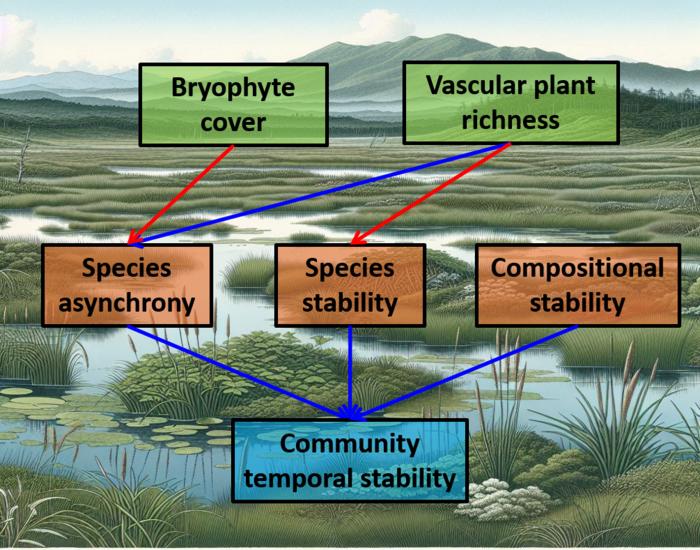Understanding the dynamics of subalpine and boreal moorlands is critical in a world increasingly affected by climate change. Researchers from YOKOHAMA National University have delved deep into the complexities of these ecosystems, aiming to uncover the intricate relationships that contribute to community stability within plant communities. Their study provides groundbreaking insights into how various ecological factors collectively influence the resilience and stability of these environments.
Moorlands serve essential roles in climate regulation, acting as significant carbon sinks while also regulating local weather patterns. These ecosystems are characterized by their unique plant communities, which are shaped by various environmental factors, including hydrology, soil characteristics, and biotic interactions among species. In a bid to preserve these vital communities, understanding the mechanisms that underpin their stability is essential. The results from YOKOHAMA National University’s long-term monitoring project, named ‘Monitoring Site 1000’, reveal complex interactions between biodiversity and ecosystem stability.
The researchers focused on several key factors in their analysis: species richness, species asynchrony, species stability, community compositional stability, and bryophyte cover. Each of these elements plays a pivotal role in determining the temporal dynamics of plant communities, influencing how resilient these ecosystems are to environmental stressors. While species richness has long been considered beneficial for community stability, this study highlights that the relationship is far more nuanced than previously thought.
Species asynchrony refers to the variation in species abundance across different time periods. This phenomenon enables ecosystems to maintain diversity by ensuring that various species can thrive under changing environmental conditions. By filling multiple temporal niches, these plants collectively enhance overall community resilience. The study emphasizes that greater asynchrony among species fosters a more robust ecological network, ensuring that some species can persist despite environmental fluctuations.
The findings indicate that species stability is significantly influenced by the dominant species within the community. For instance, the presence of specific vascular plants, such as Moliniopsis japonica, serves as a stabilizing force, allowing the community to maintain its structure and function over time. This insight is particularly pertinent as many dominant herbaceous species face threats from habitat loss and woody encroachment. Protecting these species is essential for preserving moorland stability and, by extension, the ecosystem services that these habitats provide.
In contrast, bryophyte cover emerged as a destabilizing force within the moorland communities studied. Particularly, the influence of Sphagnum mosses was noted to decrease species asynchrony, demonstrating their significant role in shaping community dynamics. The results indicate that while bryophytes may contribute to habitat stability, their dominance can limit the ability of vascular plants to adapt and thrive in fluctuating conditions.
The researchers reported that compositional stability—essentially the maintenance of consistent species groups over time—was integral to preserving community stability. It was found that stable compositions of species contributed to enhanced temporal stability, allowing these ecosystems to better withstand environmental changes. This finding underscores the necessity of maintaining a diverse array of species within plant communities to ensure ecological resilience under varying conditions.
While the current study did not establish a clear relationship regarding the role of species richness in community stability, it suggests that further research should investigate these dynamics over more extended periods. Longitudinal studies may provide the insights needed to clarify the complexities of species interactions and their collective influences on ecological stability. Understanding how species richness intertwines with other stability factors will enhance conservation strategies aimed at preserving moorlands.
Climate change represents a formidable challenge for ecosystems globally, and the findings from this research suggest that increasing temperature fluctuations may amplify the destabilizing effects of bryophyte dominance. As climate patterns shift, the delicate balance within moorland communities could be further disrupted, emphasizing the urgency for conservation strategies that prioritize species diversity and habitat protection.
The implications of this research go beyond mere academic interest; they reach into the realm of environmental policy and management. The critical role of dominant species should be integrated into conservation practices, particularly regarding management efforts for habitats facing ecological pressures from expanding woody species and changing land use patterns. The study advocates for a proactive approach to conservation, focusing on the protection of species that play vital roles in maintaining community stability.
Moreover, the ‘Monitoring Site 1000’ project presents a model for future ecological research. The insights gleaned from an ongoing, long-term monitoring effort can guide policymakers and conservationists in their strategies to mitigate the impacts of climate change on vulnerable ecosystems. This comprehensive dataset will allow future studies to build upon these findings, expanding our understanding of the interactions that underpin ecological stability.
In summary, the research conducted by YOKOHAMA National University elucidates the multifaceted relationships that govern the stability of subalpine and boreal moorlands. The interplay of species asynchrony, stability, compositional dynamics, and bryophyte influence reveals a complex ecological tapestry that plays a crucial role in preserving these vital ecosystems. As we continue to face unprecedented environmental changes, these findings underscore the importance of integrating scientific research into actionable conservation strategies.
The insights discovered in the moorland study shine a light on the intricate dependencies within ecosystems and remind us of the intricate balance that must be managed to ensure future ecological resilience. This work paves the way for progressive research, emphasizing the need for interdisciplinary collaboration as we strive to confront the impacts of climate change on our planet’s most sensitive environments.
Ultimately, the study not only contributes to our scientific knowledge but also calls for concerted action from policymakers, conservationists, and researchers alike. By prioritizing the preservation of critical species and maintaining ecological diversity, we can foster resilience in vulnerable ecosystems, ensuring a healthy planet for generations to come.
Subject of Research: The influence of species asynchrony, stability, and compositional factors on moorland community stability.
Article Title: Species asynchrony, species stability, and compositional stability jointly stabilize, while bryophyte cover destabilizes plant communities across Japanese moorlands.
News Publication Date: 27-Feb-2025.
Web References: Science of The Total Environment
References: DOI 10.1016/j.scitotenv.2025.178955
Image Credits: Credit: YOKOHAMA National University
Keywords: Ecological stability, community stability, plant communities, vascular plants, species richness, environmental monitoring, climate change effects.




